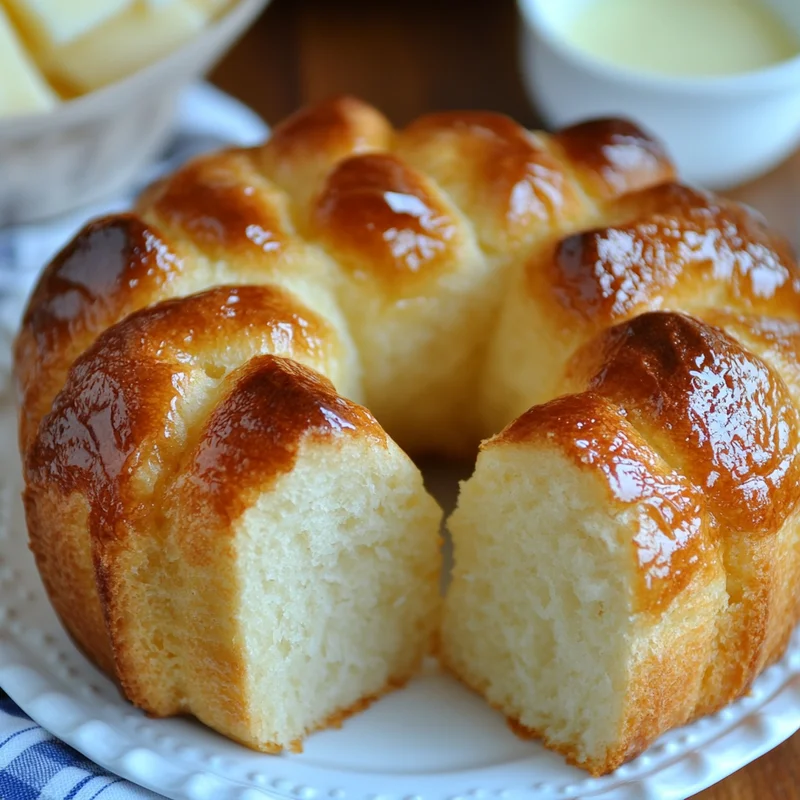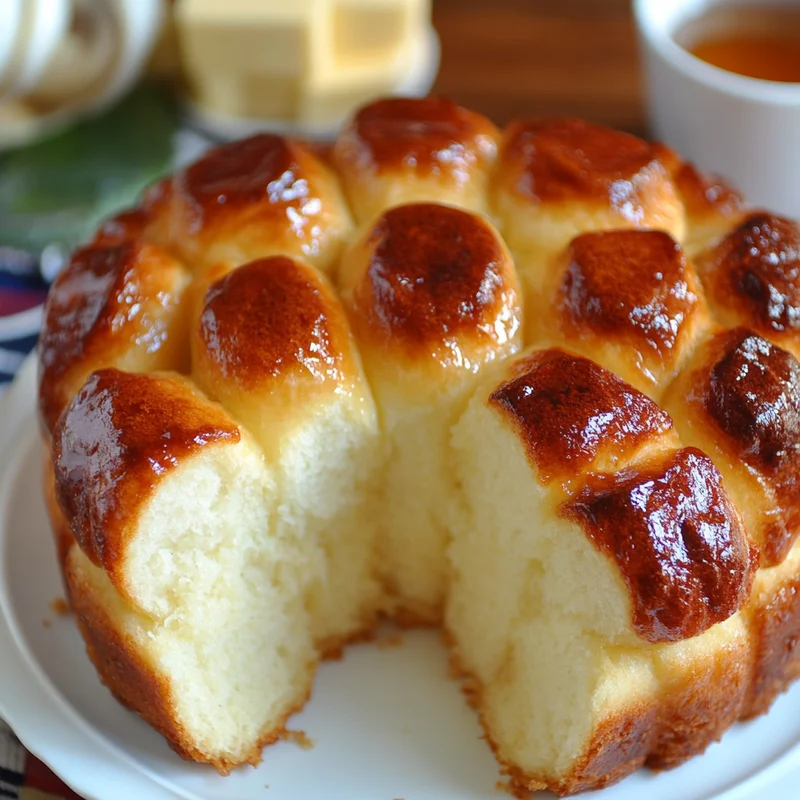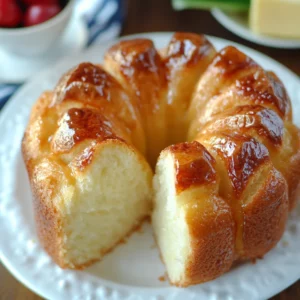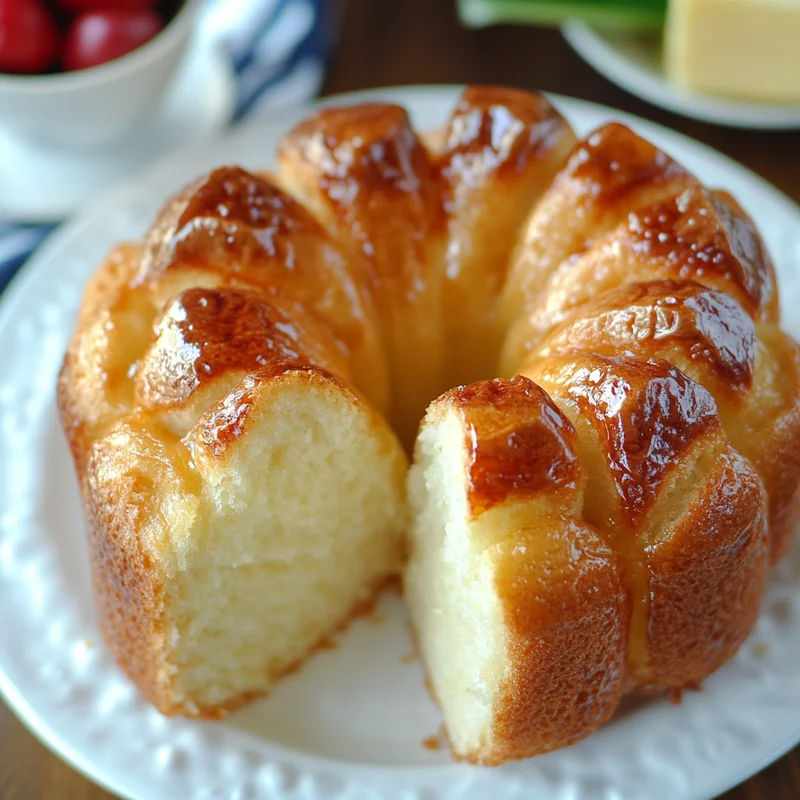Introduction
Oh my goodness, get ready to take a trip down memory lane! There are some recipes that just instantly transport you back to childhood, aren’t there? For me, Grandma Coco’s Monkey Bread is one of those magical treats. I can still remember the smell filling her kitchen, the excitement of pulling apart those warm, gooey, cinnamon-sugar coated pieces, and the pure joy of sticky fingers. It wasn’t just dessert; it was an experience!
Maybe you knew it as “pull-apart bread” or “bubble bread,” but no matter the name, this sweet, sticky, delightful creation is an absolute classic. And while it looks impressive, I promise you, making it from scratch with Grandma Coco’s simple, forgiving yeast dough recipe is easier and more fun than you might think! Forget those cans of biscuits; this homemade version is truly next-level cozy comfort.
Why You’ll Love This Recipe
- Fast-ish & Rewarding: While yeast dough takes a little time for rising, the hands-on work is minimal, and the result is absolutely worth the wait!
- Easier Than You Think: Don’t be intimidated by yeast! This recipe is very forgiving and perfect for beginners.
- Incredibly Giftable: Bake one for a friend, neighbor, or hostess – it’s always a welcome surprise!
- Ultimate Crowd-Pleaser: Seriously, who can resist warm, sticky, pull-apart bread? It disappears in minutes!
- Nostalgic & Cozy: It smells like home and tastes like pure comfort.

Ingredients
Here’s what you’ll need to whip up a batch of this amazing dough:
- 2 Eggs: Room temperature is best for incorporating into dough, but don’t stress too much if they’re cold.
- 7 cups All-Purpose Flour: The backbone of our dough!
- 1 tsp Salt: Balances the sweetness and brings out the flavor.
- ½ cup Granulated Sugar: Just enough to sweeten the dough itself.
- 1 tbsp Dry Yeast: This is what makes the magic happen and gives us that lovely rise. Active dry or instant yeast both work!
- 4 tbsp Oil: Adds richness and helps keep the dough tender. Vegetable or canola oil is fine.
- 12 tbsp Salted Butter: That’s one and a half sticks! Adds amazing flavor and tenderness. Melted for the dough. (You’ll need more butter and sugar for the coating later!)
- 2 cups Warm Water: The ideal temperature for activating yeast is usually between 105-115°F (40-46°C). Think warm bathwater, not hot.
You will also need ingredients for the classic monkey bread coating:
- Melted butter (usually another stick or more)
- Granulated sugar (about 1-2 cups)
- Ground cinnamon (about 1-2 tablespoons, or to your liking!)
- Optional: Brown sugar for extra gooeyness, nuts, raisins, or a simple glaze (powdered sugar + milk/vanilla)
How to Make It
Let’s turn these simple ingredients into monkey bread magic! While the recipe provides the dough ingredients, here’s how Grandma Coco would turn this into the classic pull-apart treat. You’ll want a large bundt pan for this!
- Activate Your Yeast: In a large mixing bowl (or the bowl of your stand mixer), combine the warm water and about a teaspoon of the ½ cup sugar. Sprinkle the dry yeast over the top. Give it a gentle stir and let it sit for 5-10 minutes. It should get foamy and bubbly – that means your yeast is alive and happy! If it doesn’t foam, your water might not have been warm enough, or your yeast might be old. Start over with new yeast and check the water temperature.
- Mix Wet Ingredients: Once the yeast is foamy, whisk in the 2 eggs, 4 tbsp oil, and the 12 tbsp of melted butter into the yeast mixture.
- Combine Dry Ingredients: In a separate bowl, whisk together the 7 cups flour, 1 tsp salt, and the remaining granulated sugar (from the ½ cup).
- Bring it Together: Gradually add the dry ingredients to the wet ingredients, mixing with a wooden spoon or a stand mixer with the dough hook attachment. Mix until a shaggy dough forms.
- Knead the Dough: Turn the dough out onto a lightly floured surface and knead for about 6-8 minutes by hand, or run your stand mixer on low speed for about 5-7 minutes. You’re looking for a smooth, elastic dough that springs back slightly when you poke it. It might be a little sticky, and that’s okay!
- First Rise (Proofing): Lightly grease a clean large bowl. Place the dough ball in the bowl, turning to coat all sides. Cover the bowl tightly with plastic wrap or a clean kitchen towel. Let it rise in a warm, draft-free spot until doubled in size, usually 1 to 1.5 hours. I often place mine in a slightly warm (but turned off!) oven.
- Prepare for Assembly: While the dough is rising, generously grease your bundt pan. Set up two shallow dishes: one with melted butter (you’ll likely need another stick or more for this step!) and the other with a generous mixture of granulated sugar and cinnamon. About 1-2 cups sugar mixed with 1-2 tablespoons cinnamon is a good starting point.
- Punch Down and Shape: Once the dough has doubled, gently punch it down to release the air. Turn the dough out onto a lightly floured surface. You can either roll the dough into a log and cut off small pieces (about 1-inch size is perfect), or simply pinch off pieces of dough about the size of a large marble or gumball.
- Coat the Dough Balls: Take each small piece of dough and quickly roll it in the melted butter, letting excess drip off. Then, drop it into the cinnamon-sugar mixture and roll it around until it’s fully coated.
- Layer in the Pan: Start placing the coated dough balls into the prepared bundt pan. Don’t pack them in too tightly at first. Scatter them around to form an even layer on the bottom. Continue layering the balls until you’ve used all the dough. Pour any leftover melted butter and any remaining cinnamon-sugar mixture over the top of the balls in the pan. This helps create that signature gooey bottom (which becomes the top when you flip it!).
- Second Rise: Cover the bundt pan loosely with plastic wrap or a clean towel. Let the monkey bread rise again in a warm spot for about 30-45 minutes, or until it looks puffy and the balls have nestled together.
- Bake: Preheat your oven to 350°F (175°C). Remove the plastic wrap and bake for 30-40 minutes, or until the monkey bread is golden brown and cooked through. You can test for doneness by inserting a skewer or toothpick into the center (try to get between the balls) – it should come out clean, and the internal temperature should be around 190-200°F (88-93°C). If it’s browning too quickly on top, you can loosely tent it with foil.
- Cool and Flip: This is the exciting part! Let the monkey bread cool in the bundt pan on a wire rack for about 5-10 minutes. Any longer, and the sugary syrup might cool and stick. Place your serving plate or platter upside down over the bundt pan, and carefully but confidently flip the whole thing over. Lift the bundt pan off slowly. If any balls stick, gently nudge them out and place them on top.
- Serve Warm: Let it sit for just another minute or two, then gather everyone around to pull apart the warm, sticky pieces!
Substitutions & Additions
This recipe is fantastic as is, but feel free to play around!
- Make it Nutty: Add chopped pecans or walnuts to the bottom of the bundt pan before adding the dough balls, or mix them into the cinnamon-sugar coating.
- Add Some Fruit: A handful of raisins or dried cranberries can be tossed in with the dough balls.
- Chocolate Lovers: Drop a chocolate chip into the center of some dough balls before coating!
- Citrus Twist: Add some orange or lemon zest to the cinnamon-sugar mixture.
- Brown Sugar Boost: Swap some or all of the granulated sugar in the coating for light or dark brown sugar for an even deeper caramel flavor and gooey texture.
- Easy Glaze: Whisk together powdered sugar with a little milk or water and a splash of vanilla extract until you get a pourable consistency. Drizzle it over the warm monkey bread after flipping.

Tips for Success
- Warm Water is Key: Make sure your water isn’t too hot (which can kill the yeast) or too cold (which won’t activate it). Aim for that 105-115°F range.
- Give Yeast Time to Bloom: Don’t rush the initial yeast-water-sugar step. Foaming is a good sign!
- Proper Kneading: Develop that gluten! It makes for a lovely texture. The dough should feel smooth and elastic.
- Warm Rising Spot: Yeast loves warmth! A slightly warm, turned-off oven or a spot near a sunny window works well for proofing.
- Don’t Overcrowd the Pan (initially): While they will expand, try to layer the balls rather than just dumping them all in a pile.
- Cooling Time Matters: Stick to the 5-10 minute cooling in the pan before flipping. Any longer and you risk the syrup hardening and sticking.
- Grease Liberally: Don’t be shy with the butter or cooking spray when greasing your bundt pan! This is crucial for a clean release.
How to Store It
Monkey bread is definitely best served warm and fresh! However, if you have leftovers (a rare occurrence in my house!), you can store it.
- At Room Temperature: Cover the monkey bread tightly with plastic wrap or aluminum foil, or place it in an airtight container. It will keep at room temperature for 1-2 days. The texture will change slightly, becoming less gooey as it cools.
- To Reheat: The best way to revive leftover monkey bread is to gently reheat it. You can microwave individual portions for 15-30 seconds, or wrap a larger section loosely in foil and warm it in a 300°F (150°C) oven for 10-15 minutes until soft and warm again.
- Freezing: While technically possible, freezing can significantly change the texture. It’s really best enjoyed fresh.
FAQs
Got questions? Let’s tackle a couple common ones!
Q: Can I make the dough ahead of time?
A: Yes! You can make the dough, let it complete its first rise, then punch it down, shape the balls, coat them, and place them in the greased bundt pan. Cover tightly and refrigerate overnight (up to 12-18 hours). In the morning, let it sit at room temperature for about 30-45 minutes before baking as directed. The second rise will happen slowly in the fridge.
Q: My monkey bread stuck to the pan! What happened?
A: This is usually because the pan wasn’t greased generously enough, or you waited too long before flipping it out after baking. Make sure to really get into all those nooks and crannies of the bundt pan with butter or cooking spray, and flip it within that 5-10 minute window.
Q: Can I use frozen dinner rolls instead of making the dough?
A: Absolutely! While making the dough from scratch using Grandma Coco’s recipe is part of the charm (and results in amazing flavor!), using frozen dinner rolls (like Rhodes brand) is a popular shortcut. Thaw them according to package directions, then cut each roll into 3-4 pieces and proceed with the butter and cinnamon-sugar coating steps.
So there you have it! A taste of my childhood, ready to become a warm, sticky, happy memory in your own kitchen. Give Grandma Coco’s Monkey Bread a try – I have a feeling you’re going to love pulling it apart!

Grandma Coco's Famous Homemade Monkey Bread Recipe
Equipment
- Large mixing bowl Or stand mixer bowl
- Stand Mixer Optional, with dough hook attachment
- Separate bowl
- Lightly floured surface
- Clean large bowl For first rise
- Plastic wrap Or clean kitchen towel
- Bundt pan Large
- Shallow dishes 2 needed for butter and cinnamon-sugar coating
- Wire rack
- Serving plate Or platter
- Skewer Or toothpick, optional for testing doneness
Ingredients
Dough
- 2 Eggs Room temperature is best
- 7 cups All-Purpose Flour
- 1 tsp Salt
- 0.5 cup Granulated Sugar For the dough
- 1 tbsp Dry Yeast Active dry or instant yeast
- 4 tbsp Oil Vegetable or canola oil
- 12 tbsp Salted Butter Melted, for the dough (1.5 sticks)
- 2 cups Warm Water 105-115°F (40-46°C)
Coating & Assembly
- Melted butter About 1 stick or more needed for coating and pouring over
- Granulated Sugar About 1-2 cups for coating and pouring over
- Ground Cinnamon About 1-2 tablespoons for coating and pouring over
Instructions
- Activate Your Yeast: In a large mixing bowl (or the bowl of your stand mixer), combine the warm water and about a teaspoon of the ½ cup sugar. Sprinkle the dry yeast over the top. Give it a gentle stir and let it sit for 5-10 minutes. It should get foamy and bubbly – that means your yeast is alive and happy! If it doesn't foam, your water might not have been warm enough, or your yeast might be old. Start over with new yeast and check the water temperature.
- Mix Wet Ingredients: Once the yeast is foamy, whisk in the 2 eggs, 4 tbsp oil, and the 12 tbsp of melted butter into the yeast mixture.
- Combine Dry Ingredients: In a separate bowl, whisk together the 7 cups flour, 1 tsp salt, and the remaining granulated sugar (from the ½ cup).
- Bring it Together: Gradually add the dry ingredients to the wet ingredients, mixing with a wooden spoon or a stand mixer with the dough hook attachment. Mix until a shaggy dough forms.
- Knead the Dough: Turn the dough out onto a lightly floured surface and knead for about 6-8 minutes by hand, or run your stand mixer on low speed for about 5-7 minutes. You're looking for a smooth, elastic dough that springs back slightly when you poke it. It might be a little sticky, and that's okay!
- First Rise (Proofing): Lightly grease a clean large bowl. Place the dough ball in the bowl, turning to coat all sides. Cover the bowl tightly with plastic wrap or a clean kitchen towel. Let it rise in a warm, draft-free spot until doubled in size, usually 1 to 1.5 hours. I often place mine in a slightly warm (but turned off!) oven.
- Prepare for Assembly: While the dough is rising, generously grease your bundt pan. Set up two shallow dishes: one with melted butter (you'll likely need another stick or more for this step!) and the other with a generous mixture of granulated sugar and cinnamon. About 1-2 cups sugar mixed with 1-2 tablespoons cinnamon is a good starting point.
- Punch Down and Shape: Once the dough has doubled, gently punch it down to release the air. Turn the dough out onto a lightly floured surface. You can either roll the dough into a log and cut off small pieces (about 1-inch size is perfect), or simply pinch off pieces of dough about the size of a large marble or gumball.
- Coat the Dough Balls: Take each small piece of dough and quickly roll it in the melted butter, letting excess drip off. Then, drop it into the cinnamon-sugar mixture and roll it around until it's fully coated.
- Layer in the Pan: Start placing the coated dough balls into the prepared bundt pan. Don't pack them in too tightly at first. Scatter them around to form an even layer on the bottom. Continue layering the balls until you've used all the dough. Pour any leftover melted butter and any remaining cinnamon-sugar mixture over the top of the balls in the pan. This helps create that signature gooey bottom (which becomes the top when you flip it!).
- Second Rise: Cover the bundt pan loosely with plastic wrap or a clean towel. Let the monkey bread rise again in a warm spot for about 30-45 minutes, or until it looks puffy and the balls have nestled together.
- Bake: Preheat your oven to 350°F (175°C). Remove the plastic wrap and bake for 30-40 minutes, or until the monkey bread is golden brown and cooked through. You can test for doneness by inserting a skewer or toothpick into the center (try to get between the balls) – it should come out clean, and the internal temperature should be around 190-200°F (88-93°C). If it's browning too quickly on top, you can loosely tent it with foil.
- Cool and Flip: This is the exciting part! Let the monkey bread cool in the bundt pan on a wire rack for about 5-10 minutes. Any longer, and the sugary syrup might cool and stick. Place your serving plate or platter upside down over the bundt pan, and carefully but confidently flip the whole thing over. Lift the bundt pan off slowly. If any balls stick, gently nudge them out and place them on top.
- Serve Warm: Let it sit for just another minute or two, then gather everyone around to pull apart the warm, sticky pieces!

